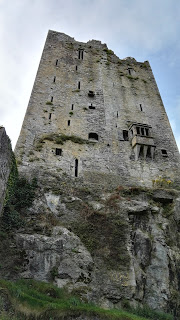A first date guide to the
South Quays
Meet at the gates of Ireland’s foremost university, Trinity College.
While this is not on the South Quays, it is by far the easiest place to meet on
the southside – as long as no disgruntled pensioner is currently trying to ram his
car through it. If you fancy your chances, head for the Book of Kells inside its
grounds. Queuing to see it on a summer’s day is the relationship equivalent to six
months backpacking together through South America. If you are still talking by the
time you finally reach the top of the line, you’re as good as married.
(If you’re coming from the northside, meet
on O’Connell Street – at the Spire if your date has only moved to Ireland; under
Clery’s clock if they are originally from the country; or at the GPO if you’re one
of those people who hate it when others don’t stand up during the national anthem.)
Cultural you: Head first
for cultural quarter of Temple Bar. Unless you want to give the impression that
you have a small drinking problem, don’t suggest joining the English stag from
Lancashire for a pint. Instead, save the €100 you would have spent on a round of
drinks and bring your date to any of the myriad of cultural hot-spots surrounding
you, from the IFI and Meeting House Square to the Project Arts Centre and the National
Photographic Archive. To help impress, be on first-name terms with someone working
in a shop at the far end of Temple Bar who you just happen to bump into, preferably
one that sells books.
Historic you: Bring
them up the river to Wood Quay, where one of the most extensive Vikings ruins in
northern Europe was uncovered in the 1970s and then buried in concrete when Dublin
Corporation built their headquarters here. Point out the half-buried Viking ship
on the pavement just up from it, which they left out as a warning to others. Mumble
under your breath something about ‘Charles Stuart Parnell’, ‘Romantic Ireland being
dead and gone’, how ‘it eats you up every time’ and look emotional. Wave a fist
at the building if you feel it appropriate and then lighten the atmosphere by heading
up to grab some fish and chips in Leo Burdock’s before visiting Ireland’s oldest
cathedral, Christ Church – because who doesn’t want to see a mummified cat chasing
a mummified mouse? Good times!
Social you: Head down
to your final stop, the Guinness Storehouse. Resist the urge to tell him/her that
you brew your own craft beer. Instead, wander around the most-visited tourist destination
in the country, getting to know each other and playing ‘What country do you think
they are from?’. Finish it with a night out (for ‘night’, read ‘early evening out’),
hanging with a group of really friendly American retirees from Utah in the Gravity
Bar. Not only will your witty Irish ripostes make you seem like the friendliest
person there, thus guaranteeing a second date, but you can be sure that most of
those Americans are not going to drink their complimentary Guinness, which means
there will be plenty of spare pints to go around. Word of warning: this only works
the once before the barman get wise to your ways so choose that first date carefully.












